Blanket Chest
Posted 23 March 2018
This is the introductory page for a paid video series. Want to watch more of this project? Select the best option below to get started.
Blanket chests, also known as hope chests in the USA, were used for storing valued items as well as bulky duvets, quilts and blankets, but you might also use them to store and protect many other family possessions such as photo albums, children’s’ toys, crafting supplies or indeed your collection of woodworking tools. Paul’s design features mortise and tenon joinery and raised panels, as well as the development of the shaped and flared legs.
- Knife
- Pencil
- Combination Square
- Combination gauge (or marking gauge and mortise gauge)
- Tape/Ruler (or both)
- Sliding bevel
- Chisel hammer or mallet
- Chisels (1/4″, 3/8″, 3/4″ and 1″)
- Hand router plane (see how to make a ‘Poor Man’s Router here)
- Smoothing plane (No 4)
- *Jack Plane (No 5) (recommended if preparing your wood from rough sawn)
- Spokeshave (flat)
- Plough Plane
- *Scrub Plane
- Mortise guide
- Winding Sticks
- Handsaw (recommended rip and crosscut)
- Tenon saw
- No 80 Cabinet Scraper
- Card scraper
- Hand drill or drill-driver
- *Rasp
- File (10”)
- Screw driver (flat and pozi)
- Square Awl
* = optional
Joints List
- Haunched and mitred mortise and tenon

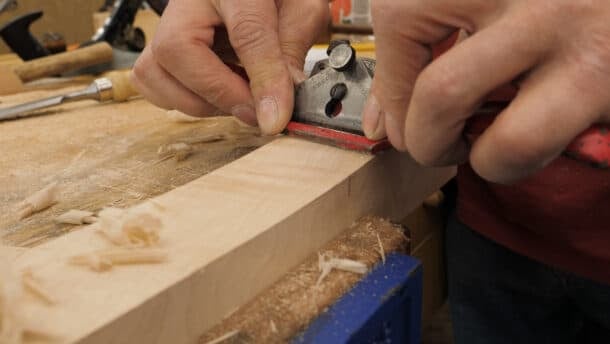
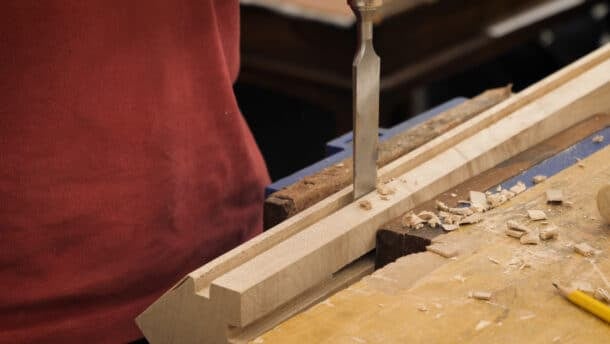
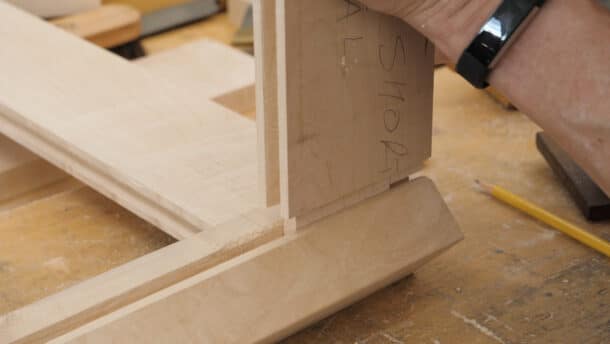
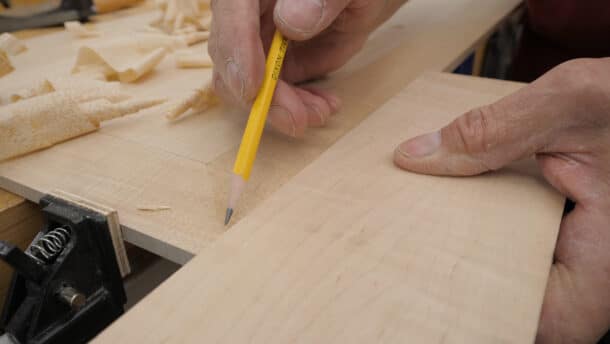
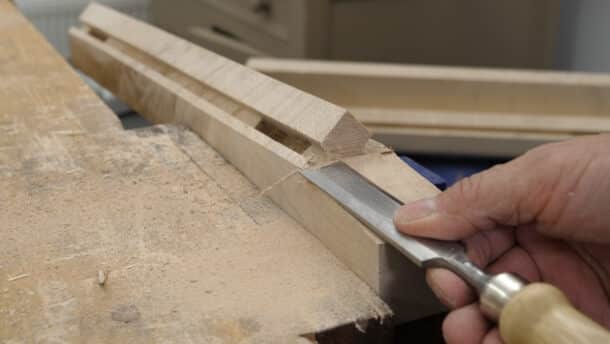
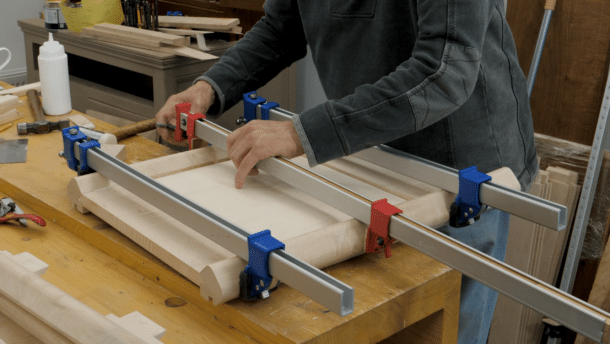
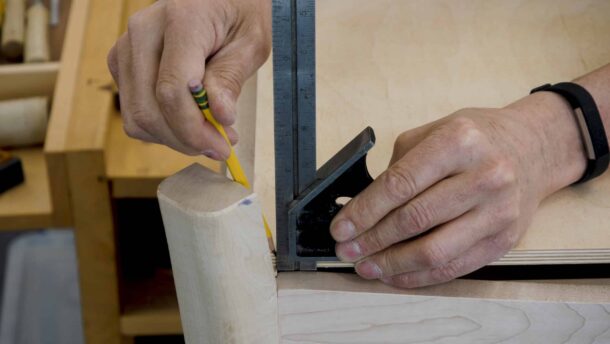
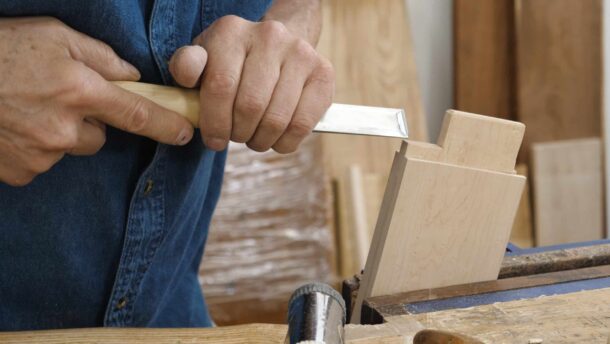
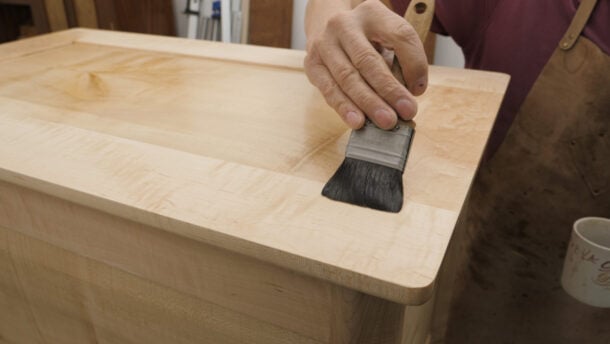
Those corner legs look very tricky. I cant wait!
I’m looking forward to this!
Would Paul please show us how to profile the chest edge with something other than a roundover, maybe a thumbnail? It should be something that will require us to learn techniques that carry to other profiles we might want for table edges or mouldings, so maybe a scratch block or scratch block plus filletster and gouge or plus hollows and rounds, etc.
You could do this in a separate tool/technique video if this project is already planned out or planned out and filmed. If some members don’t have the tools, well the core project is still available to them, or it’s just a technique video they can put aside until they want to do it.
Many of us have asked about this patiently for at least a couple years, maybe three. This looks like an exciting project for many members, and it looks like it will extend carcase work from dovetails to frame and panel, but by simply adding some variations, like how to make profiles, you will do a lot to help even more people.
This may seem a small thing, but adding a profile can transform the appearance of a piece. I know there may be a lot to cover, but if we just start doing some of it, it can build over time as addition to or variations on the projects, or as separate technique videos.
If this is already in another video that I’ve overlooked, please let me know. Thank you for the excellent cornice video, but I think we can go further now. If there is another why to send requests for projects, I don’t know what it is, so I’m posting here.
Thank you for hearing what are meant to be constructive suggestions, not complaints.
Hi Ed …I’m with you on moulding plane use, I have a nice selection and have asked Paul and Phil many times for instruction on there use…..together with scratch tool and shooting board.
Paul has explained that he fears that the majority may not have any and as I know, so many are going for silly prices, many in poor condition. ( so I can see his logic )
Using a scratch stock combined with a poor man’s rebate tool can easily produce a simple ovalo …..burnished with shavings will give a silky finish…….used on a sticking board can easily open up many variations.
Perhaps Paul’s hesitance is another reason why he has removed his collection from our view?? Thereby reducing our desire for him to use them……Thank you Paul for hope chest intro…looking forward to it…….best John 2V
I don’t buy that. First, if a project relied entirely upon tools not generally available, then it would be true that many would be left out. But, as an added direction or option for a project or as a technique video, it supports those who are interested and helps Paul pass on his teaching and knowledge. Second, those who are interested and motivated can make the key planes they need or will, in some way, find what they need.
Cornflower is correct about Paul’s reasoning. And using your logic, he has already shown how to make large scale moulding using the compass plane form another WMMC lesson. A plane is a plane in that regard, and if all you want are simple mouldings you can scale down the techniques there to do it. Making fancy or complex moulding is in many ways art of it’s own much like turning.
Moulding planes themselves are very much outside of what Paul considers essential and a bit outside the scope of what the essential tools can fabricate as “extra” tools. He might at some point do a video on using them like the video of carving a rosetta, but I doubt we will see them as part of a major project.
Hi ehisey I don’t understand how a compass plane can be described as a moulding plane, it is used for convex or concave shaping. I must have sadly missed Paul’s instruction on its use……..i respect your opinion but totally disagree when you say the use of moulding planes is an art form and greatly disagree with any connection to wood turning, yes not easy to use or understand but that’s where Paul comes in and as Ed says “many have patiently asked for couple of years” again as Ed says could open up a whole area of interest for Paul’s followers
I agree with you Ed, totally.
As you say many of us have asked Paul to talk of using the tools you list, he just will not, shame……..SO COME ON PAUL ….PLEASE
I didn’t want to get into a debate, but I agree with ehisey that we don’t need to be shown how to use a profiling plane. He’s right, it’s just another plane. But, that’s not what I’m requesting. Many profiles are made via gouge, filletster and scratch block or with filletster, hollows and rounds. I’d like to know how. In fact, this is exactly in keeping with Paul’s philosophy. Rather than buying a million profiled planes, I suspect that learning a few techniques will show you how to do a lot with just a scratch block or with a quite limited number of hollows and rounds. My problem is that, while I’ve seen the results of others, I never get good results myself. The compass plane video showed a cornice, but that method will not create smaller profiles, like a table edge, belt moulding, or stuck panel mouldings. It was a nice video and useful, but it doesn’t cover the space.
Btw, it wasn’t a compass plane. It was “a plane round in two directions.” : – )
Hello Ed,
We will have a think about how we can show some more shaping and different profile techniques, most likely in seperate videos as our aim for the series is to not add too many extra details that aren’t key to the project. It also makes the techniques more accessible.
Paul did a tiny bit of beading in wallclock episode 5 which may be of interest. The best way to submit project requests is probably through the contact tab at the top.
All the best,
Phil
Bingo….-:) -:)
Phil, thank you in advance for whatever you decide to do. -Ed
Hi Ed. Thank you for your constructive comments.
I am really looking forward to Paul’s instruction……John
having a series on how to produce various mouldings with hollows and rounds,scratch stocks and complex planes would be awesome.
I’ve looked for a while but there’s no video that does this,plus I’d rather pay to be taught this by Paul and the team,trusted and true is the relationship I feel towards Paul and the team.
Also as part of the series there could be section on how to make your own moulding planes,shaping the iron and plane body etc.
Hurrah! First, thanks for pushing ahead whilst the shop is under construction. Appreciate the commitment to delivering projects for us to enjoy.
Second, I am excited about the idea of Paul sharing a bit more of the design / problem-solving process than we usually have a chance to see. From an educational point of view, it helps when we see not only the solution, but the method of approaching a design choice or a “surprise” (read problem, unforeseen difficulty, or mistake).
I liked the curved legs. I recently made project inspired by James Krenov. But I could never figure out how Krenov did his joinery.
Maybe this project will offer some insight.
Never even heard of a pozi screw head until today but after a Google search I think I have seen them before–just never knew what they were! Is this a style of screw that Paul intends to use instead of Philips head screws due to superior design or is it just incidental to this project (and for a specific reason?)?
I think “pozi screws” were one of the first cross head screws after slotted screws…they had a soft head still requiring a pilot hole.
Over time screws have advanced through so many variations…now we have high tensile twin thread self cutting tipped screws requiring special bits for our amazing battery drills
John 2V
Looking forward to seeing how the bottom installed for this type chest. That has been the one stumbling block in designing one like this myself already. Well, that and still having to source 12/4 stock at least 4 inches wide.
I don’t generally comment on the site (I can never really think of anything to say) but I’m so looking forward to this one. Looking at the plans I think we’re in for an extra learning treat. These legs done at 45 degrees to the main panel look really interesting. Can’t wait for episode one.
Hi Jon,
Glad it ticked some boxes for you. It’s going to be a fun project.
Hi Paul,
In you into video you mention that you are using Sycamore. As I haven’t used this wood (I’m in the US), I looked it up.
Below is what I discovered and I wonder if you agree with this statement?
Your input might would help us understand and source our wood selection. Thank you and keep up the good work!
Bob Curry
Centreville, VA.
Sycamore is one of those names used for a variety of species, and this common usage can lead to confusion. The authors of the Encyclopedia of Wood try to make sense of the situation. “What the British call sycamore (Acer pseudoplatanus), the Americans call maple, and what the Americans call sycamore (Platanus occidentalis) the British call lacewood. What the Australians, on the third hand, call maple (actually Queensland maple, Flidersia braleyana) is part of the satinwood family (rutaceae).”
Source:https://www.woodworkingnetwork.com/wood-archives/wood-products-magazine/american_sycamore_127689238.html
I came across this while in some woods Houston. The guide was telling us about their Sycamore trees but as a Brit, I knew them to be London Plane (lacewood).
Sycamore has helicopter seed pods (maple family), plane trees have seed balls (plane family).
Acer pseudoplatanus translates as pretend-plane maple
All rather interesting when I read of sycamore trees.
I’m in the uk and they are referred to, in some quarters as weeds. They are a prolific fast growing tree, as said above dropping masses of helicopter like seed pods. The little darlings float down into our garden. What is quite amazing is that a ‘helicopter’ contains 2 seed pods joined but with their own wing ….forming a vee. They land lying flat but within two days they magically turn to upright with the seed sinking whilst the wing rots leaving a lattice of veins……nature is amazing ……BUT the seeds take root, before long, if not pulled up could result in a mini copse. In the spring and autumn they give off a dust causing a breathing problem for asthmatics……..from my limited knowledge I wasn’t aware of LONDON PLANE being a sycamore….totally different bark for a start?? I was told London Plane tress where planted in the Victorian period??
I live just off a street called Sycamore, and we have a fair number of sycamore (occidentalis) trees in the area. I’ve worked with it on a few projects, and would only recommend using occidentalis when quartersawn — it’s just too unstable otherwise. Also, it’s seriously beautiful when quartersawn. Locals sometimes call them American Plane trees, and I’d never heard of a London Plane tree, that’s interesting to learn.
You’re correct about Sycamore being unstable. It’s difficult to cure and it tends to shrink quite a bit unless it’s quartersawn. I think finding the leg material in Sycamore may be difficult too. Anything over 5/4 is hard to find. Maple, on the other hand, would be a pretty good choice and that’s what I’m leaning toward.
Hello Bob,
The sycamore that Paul used in this project seems softer to him than maple generally us, but it is indeed in the same family as the maples and can largely be used for the same purposes. Maple would serve the same function for you.
Beyond that Paul hasn’t looked into it so couldn’t really comment. Hope that helps.
Best, Phil
One of my favorite videos by Paul was done on disassembling a small table and Paul showed the marks made by the original maker. So now when ever I examine a piece of furniture I look for the same details.
The blanket chest reminded me of Jame Krenov and I took out his book and began examining the photograph on the cover. It was a closeup of the dovetails he cut on a jewelry box. On the exterior of the box it showed the scribe lines he made when laid out the dovetails. It looks like he cut the dovetails so exactly that he did not have to plane the exterior of the box in order to get a good appearance.
I despair of ever being able to cut dovetails to such a high standard.
It’s looking like a great series this,it’s facinating to realise the methodology in the series,looking back through them,I’ve been critical before,but know I see I was arrogant and ignorant lol.
The production too has come on leaps and bounds,I love the music too,it’s just lovely
Question about mitre joints meeting in a leg. not sure how much the removal of that much wood to create that internal junction might compromise the strength of the leg joint. why not 2 squared off tenons and keeping more wood in that internal area. probably a good reason but not obvious to me and never heard or read why a mitred joint was better. maybe a bigger issue with smaller dimensions. love the way this project is heading.
The mitre on the tenon means that the tenon is longer, so greater surface area on the tenon increasing the strength of the joint.
I would love to build this, along with some bookshelves and a whole bunch of other projects that require the use of the plough plane but due to the scarcity of the tool and no *definitive* guide on how to make a poor man’s version, I have to skip all the projects that require the use of this tool. 🙁
I think this is a major gap in your product offering given how scarce this particular tool is and it’s not getting any better.
I don’t think plough planes are that hard to come by. There’s normally plenty of Stanley 13-050 planes on ebay for a decent price.
Very few outside of UK. None in Aus.
Veritas makes a nice plough plane. You’ll see Paul use one from time to time.
A gorgeous tool but alas not an entry level price point
Jason, check out episode 2 of the breadboard end cutting board. Paul shows how to form s groove with a saw and chisel. It’s slower than a plough plane but it works.
An old Record or a Stanley is your best bet. I use a Stanley 45 that I got for around $100 I think. The blanket chest has 16 grooves at an average of maybe 2 feet each. I wouldn’t want to try and do that without a plough plane, but I’m lazy. You might want to have a go on a scrap piece just to see what you can do with a tenon saw and a chisel. The raised panels have to be fitted to each groove anyway so there is room for a little descrepency. Hope you find a plane though. Grooves are pretty common and a plough plane of some sort becomes pretty much essential.
I forgot about the lid. Make that 20 grooves.
Thanks for the tips Harry
They can be scarce on eBay due to collectors and such but there are specialty stores like woodcraft or highland woodworking where they should more available. You could also feasibly use your marking gauge to scribe the lines, carefully use your saw to cut the edges and then chisel out the waste or use a router plane…just a few ideas but I do agree they can be harder to find (especially in good condition).
Thanks for the suggestions David
When a tool becomes scarce or valuable somtimes it is prudent to just save your bucks,and bite the bullet, And buy new.
However if you just want to cut a groove you can look at wooden plows. I recently got one off an auction sit for under $100. It has to be locked with wedges instead of threaded but it grooved wonderfully.
I dont believe that a plow plane is an entry level tool. if you want to make panels you need one.
Another thing to look at is a tongue and groove plane. While you will be limited to distance from the edge , it would make a groove for a panel also. A wooden on of these can be found for $25-30.
Is it possible to get a material list in addition to a cut list? I do not have anywhere to really store wood so I buy what I need when I need it but not the best at figuring out what exactly I need and hate coming up short. Thank you!
Hi Adam,
Thanks for the suggestion about providing a material list, I will be sure to pass this on to the team!
Izzy
This project was always free. Why is it paid now???
https://woodworkingmasterclasses.com/?p=839181
This project is a step up for me. I believe I can do it, therefore I can. I don’t have everything in the tool list but I’m going to take my time and figure it out as I go. I’m going to make mine out of quarter sawn oak. My OCD kicked in when I was reviewing the drawings. I think there’s a mistake in the leg on page three. The beveled edges that Mr. Sellers first cut both the same width (unless I missed something in the video). But, if you do the math, the dimensions are wrong. One side is 1-5/8″ (7/8 + 3/8 + 3/8). The other side is 1-1/2″ (7/8 + 3/8 + 1/4). The rails are 7/8″ thick with a 3/8″ tenon. That leaves 1/4″ on either side of the tenon. That supports the 1-1/2″ dimension. I know, I need to take my medication. Thirty-six years of analyzing technical schematics and calibrating complex equipment will do that to you. Am I right or did I miss something in the video?